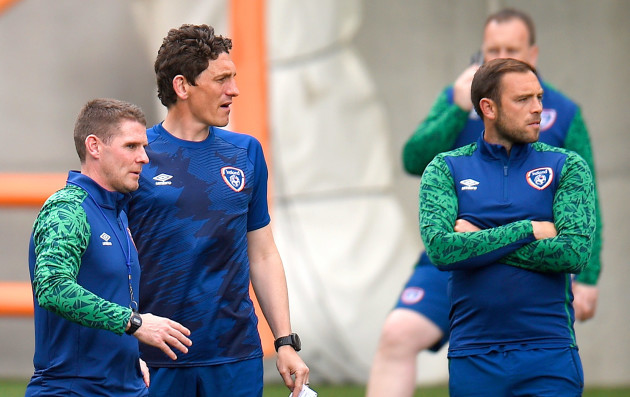SO STEPHEN KENNY is finally off the mark but let’s start with Roy Keane, and a rare moment of profound and worldly insight from his recent ramble through the woods with Gary Neville.
While disputing with a kind of melancholy acceptance the hard-man, old-school image that is thwarting his attempts to get back into management, Keane repeated a mantra: “Perception is reality.”
Some high-profile criticism of Stephen Kenny has been rooted in the perception of how he said his team would play rather than how his side have actually been playing.
Paul McGrath’s was the most notable verdict of late, saying he doesn’t believe Kenny is the right man for the job while gracefully saying he hoped he would prove him wrong.
“You have to have that ball over the top”, said McGrath. “You have to have someone reading what you are going to do so we can chase it. You can’t just keep playing football in the middle of the pitch, making nice arcs and circles. I think you have to put the ball into the box if you want to score goals. Goals are what we are lacking at the moment.”
Earlier this year, Tony Cascarino pithily summed up a lot of the criticism aimed the manager’s way. “With Stephen Kenny, I just see an idea and the idea is so perfect that there is no debate.” (Big Cas added that Ireland should play Big Shane Duffy up front.)
The reality is that there have been a plethora of ideas this year. If Kenny got the job as a starry-eyed ideologue, he has proved pragmatic since the turn of the year.
He began his first games against Bulgaria and Finland with a 4-3-3 formation that made more than 500 passes in each match but were cut open too easily in midfield, so next up was a steadier 4-2-3-1, though any hopes of bedding it in were smithereened by a luckless run of injuries and Covid cases.
When he first took the job he was asked about playing a back three and said that, while he wouldn’t rule it out totally, the subtext was clear when he added he had never really used it in his long career in club management to date.
And behold: it’s upon a back three that he’s built this World Cup qualifying campaign. There have been slight changes to it as the campaign has gone on, and it’s morphed from a 3-5-2 in Serbia to a more Chelsea-like 3-4-2-1. (It would be interesting to know how influential a role Chelsea coach Anthony Barry has played in that.)
“We have had a consistency in selection in terms of our system, we are building a way of playing”, Kenny told the travelling press in Baku last Friday morning, and expanded further after the game. “We have undergone a change in system in that period from March onwards, it suits the players we have.”
The style of play has changed too. Ireland averaged 509 passes a game in their games in 2020; in the competitive games played in 2021, that has stooped to 393.
They averaged 43 long passes per game in 2020; that’s up to 48.5 per game in 2021, meaning 11.4% of their passes have gone long this year, as opposed to 8.6% last year. The change is neatly encapsulated by one stat: when you compare this year to last, Ireland are playing one pass fewer every time they have the ball.
They are far more effective going forward this year than last, evidenced in the fact that they are, well, actually scoring goals.
2020 brought all of one goal, while they have eight in this campaign so far, which is more than they managed in the entire Euro 2020 campaign under Mick McCarthy.
It has come at the cost of defensive stability. Ireland now concede more shots and more goals on average per game compared to last year, stats only partly mitigated against by the fact they didn’t play anyone of Serbia or Portugal’s quality in 2020.
There was a definite tactic to target Azerbaijan with quick, long balls on Saturday: Ireland’s third-most frequent passing exchange was between goalkeeper Gavin Bazunu and striker Adam Idah. Bazunu hit that pass seven times, whereas he passed short to one of his three centre-backs just twice.
Kenny told us ahead of the game that Azerbaijan’s main strength was their ability to quickly flood eight players between ball and goal, so it seems he decided speed was of the essence on Saturday.
There is an argument that they did it too often, as they completely lost control of the game between Robinson’s first and second goals, though at least didn’t allow Azerbaijan create a clear-cut chance of note.
There’s a reason Ireland are playing like this: they remain more comfortable as the counter-attackers as opposed to the protagonists. The single most important fact of Saturday’s game was that Ireland scored first, and thus Azerbaijan couldn’t sit deep and ask Ireland to break them down, as happened so excruciatingly in Dublin.
Remarkably, Ireland had just 36% possession against Azerbaijan, yet it was a game they could have easily won 6-0. Ireland have had the majority of possession just twice in the group so far, and they were the home flops to Luxembourg and Azerbaijan. They still don’t have the craft to break down the deep-lying defences who are not baited into trying to press their short patterns, and solving that problem is among Kenny’s biggest challenges.
This isn’t to say that Kenny is reverting Ireland to type: they are still playing fewer long balls this year than they did in either of the previous two campaigns under McCarthy and O’Neill.
They also continue to build from the back – albeit less frequently than last year – and are showing much more variation in their attacking play than under Mick McCarthy or Martin O’Neill. There are clear signs of coaching in that regard, and the most obvious example is James McClean’s assist for Robinson’s first goal on Saturday night, as he took time to shift the ball across his feet and play a terrific pass in-field for Robinson, rather than sprint to the touchline and thwack a cross into the box as has been doing for years.
Kenny’s Ireland are not (yet) the raffish exhibitors of a free-flowing style Ireland forgot in its embrace of English football from 1988 onwards, but instead they look a hard-working team in receipt of detailed coaching and equipped with more attacking variation in an improving but still imperfect system.
The players have praised that coaching they have been getting with more enthusiasm than you typically find in media engagements: Matt Doherty has said that there would be no doubts around Kenny’s position if the world could see the standard of training, while, before everything else took over last week, Callum Robinson concurred and added that everything is done for an express purpose and for the next game.
Ireland clearly have a lot more to improve upon, and the first half against Azerbaijan was ironically the poorest 45 minutes Ireland have turned in away from home in this campaign, albeit this time they had Robinson’s individual quality to bail them out. Their maddening profligacy then returned after the break.
Kenny has also reworked the generational balance in his team, having admitted that his U21s are developing at different rates.
Whereas Bazunu, Omoamidele, O’Shea, Knight and Idah are holding their own, Molumby, Parrott, and Connolly have struggled somewhat. He has, however, coaxed some of the best international performances we’ve seen from Hendrick, Duffy, and McClean since Euro 2016, while also becoming the first Irish manager to successfully integrate Seamus Coleman and Matt Doherty into the same team, a trick we have previously been told simply could not be done.
There are still a few weaknesses in his new system. There is a tendency to be overrun and cut open too easily in midfield – Azerbaijan had plenty of opportunities to do so in Saturday’s first-half but lacked the quality to do it – and Kenny has yet to strike the right balance with his front three. Robinson and Idah are locked in and Jamie McGrath looks the best option alongside them until Robbie Brady gets back into contention.
You can take Kenny’s tweaks as a repudiation of his early-days idealism – there’s definitely a level of truth in that – but to continue to claim that the very same idealism is undermining the pursuit of results in Ireland’s World Cup qualification campaign no longer has a grounding in reality.



